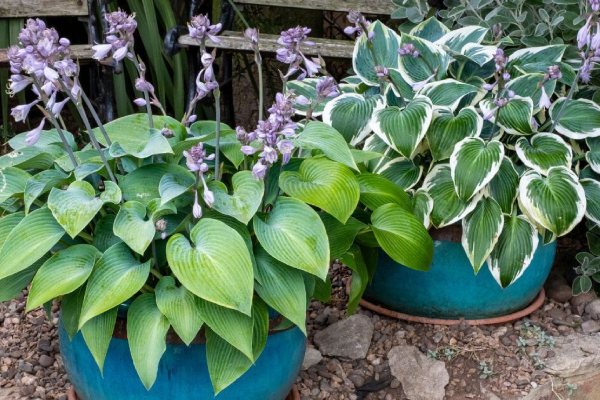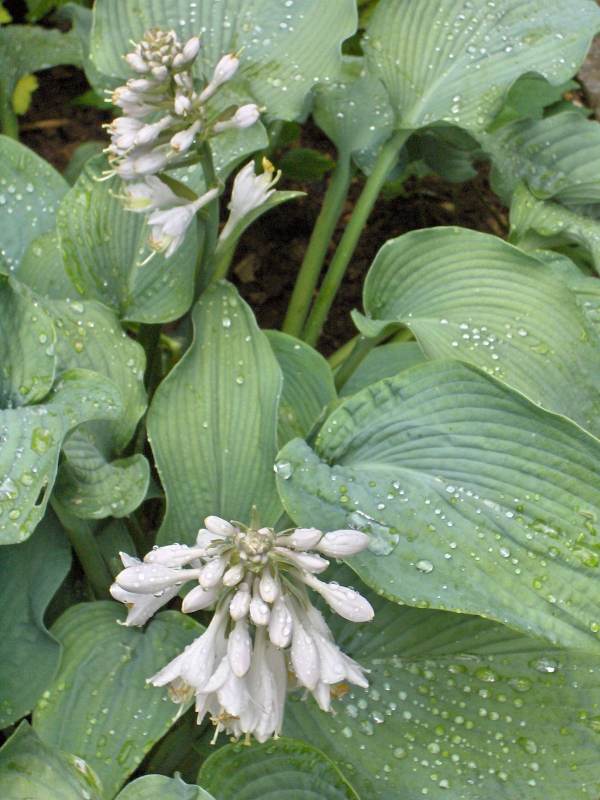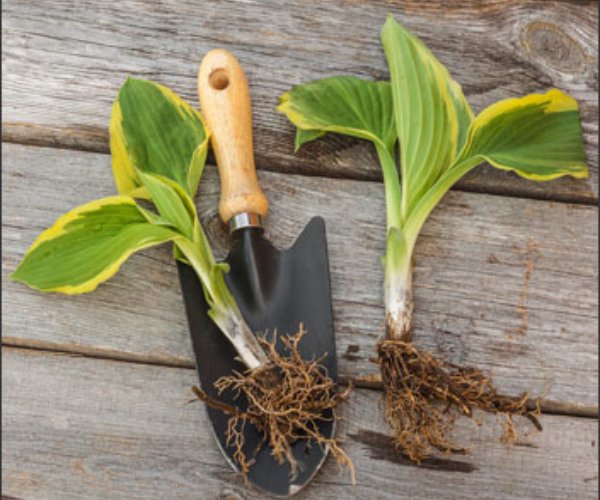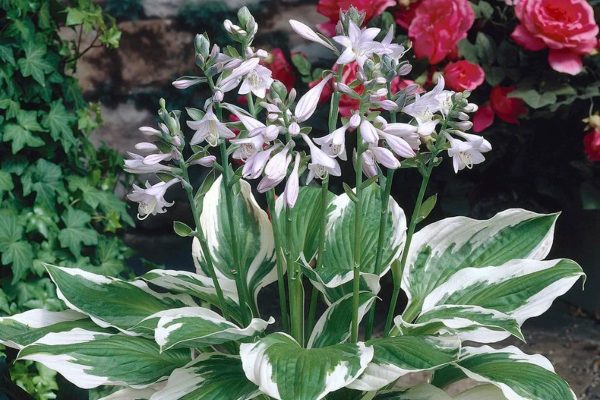Hostas, commonly known as Plantain lilies, are a perennial plant popular for its ovate or heart-shaped and variegated foliage. They can have leaves in various colors, with common striations of gold, yellow, cream, or white. Similarly, leaves have smooth, crinkled, dull, or glossy and a vibrant texture. Hostas further produce bell-like flowers sometimes fragrant in white or shades of lavender to purple. It blooms from early through late summer. Furthermore, it can grow from 2 inches to 4 feet tall. Although most hostas spread along the ground slowly by underground stems, a few cultivars do boast horizontal above-ground stems that make them suitable for use as a ground cover. In this article, learn more about hostas and find an easy way to grow them with care.
Plant Description
Plant Type: Perennial
Scientific Name: Hosta Spp.
Common Name: Funkia, Plantain lilies, Hosta
Family: Asparagaceae
Season: Summer
Native Area: Asia
Toxicity: Toxic to pets
When and Where to Plant Hostas
Plant hostas in spring, when new shoots begin to appear. This is also the best time to dig, divide, and transplant established clumps, as they can settle in well and start growing robustly. Alternatively, You can plant them early in the fall if you want them to look well-established by spring. Most hostas prefer growing in shade, although some cultivars will tolerate full sun. Therefore, light consideration is important when selecting a planting location. The hosts will do best when planted on rich, well-drained soil that maintains a constant supply of moisture. While they are somewhat drought-tolerant, they do not take too much about the prolonged dry period.

How to Grow and Care for Hostas
Light
Hosts do best in partial to full shade. Still, some varieties prefer full sunlight. Those hostas with variegated leaves will be most colorful if they receive a few hours of dappled sun each day. If these variegated hostas are kept in too much shade, their leaves may become entirely green. However, varieties that have blue or white-colored leaves cannot tolerate full sun. If they are exposed to full sun they can get sunburned or damaged.
Soil
Generally, any type of soil can be tolerated by the hosts, as long as there is good drainage. Thus, it prefers a moist type of soil yet readily fertile and well drained. You can improve clay soil by mixing with loamy soil that has organic matter such as compost.
Watering
It is necessary to water hostas sufficiently. However, make sure that the soil is moist but not too wet. Especially for those plants who are exposed in full sun they will need more water. Although some mature plants are drought-tolerant, you must try not to allow this soil to dry out completely. You can add mulch to help keep consistent moisture and prevent dry conditions.
Temperature and Humidity
The cooler the climate, the better for Hostas since they are not very tolerant of high temperatures. However, choose a location that is protected from strong winds and hail. The leaves tend to brown or dry out with hard winds or are beaten and bruised by hail. Similarly, low humidity levels can also damage the leaves of your hostas.
Fertilizer
Hostas should be fertilized during their growing season in spring to support healthy development. One should use a balanced organic fertilizer. After planting, one should fertilize within the root zone of the plant. This application feeds the soil with essential nutrients and maintains the ecosystem. However, make sure not to let the fertilizer granules come in contact with the leaves as this can cause leaf burn.
Pruning
Pruning helps maintain the health and looks of the plant. To prune hostas, you should cut away their overgrown, yellowed, damaged, or dead leaves. You should also ensure that these leaves are disposed of after pruning to minimize disease risk.

Varieties of Hosta
Hosta is a diverse group of plants with around 3000 varieties and over 47 distinct species. This variety gives gardeners many choices that create breathtaking landscapes in various growing environments. Here are some of the most common hosta varieties:
Patriot Hosta
Patriot is a distinctive, variegated plant with deep green leaves and creamy white margins. It is popular among gardeners for its heat resistance, which makes it more resilient than other hosta varieties. Additionally, it produces light purple flowers during the summer, further enhancing its ornamental appeal. Patriot performs well in various landscapes with a mature size of 12 inches tall and 30 inches wide.
Frances Williams Hosta
The ‘Frances Williams’ is one of the more popular hostas, featuring large, blue-green leaves edged with a vibrant chartreuse coloration. Its thick and puckered leaves also maintain a good, robust feature throughout the season. Besides, it also produces white funnel-shaped flowers that bloom from early to midsummer. These blooms add a delicate touch to the plant, complementing its bold leaves and enhancing its overall charm in the landscape. In terms of its history, the plant is named after Frances Ropes Williams. Frances is one of the first landscape architects to graduate from the Massachusetts Institute of Technology. In 1936, while being at Bristol Nursery in Connecticut she discovered this unique hosta. Further, this plant grows to form clumps that can spread up to 5 feet wide, with leaves growing on stems that are 2 feet tall. It grows with a mature size of 24 inches tall and 48 inches wide.
Sun Power Hosta
Sun Power is a popular hosta variety that thrives in sunny conditions. It features yellow-green leaves and produces clusters of pale purple flowers. The name ‘Sun Power’ reflects its ability to tolerate high sun exposure, with the best color achieved when planted in areas that receive morning sun and afternoon shade. The plant reaches a mature height of 12 inches and a width of 30 inches, forming a bright mound of slightly twisted golden leaves. For the best coloration, it is best to provide this hosta to provide morning sun in warmer regions and full sun in cooler areas.
Sum and Substance Hosta
Sum and Substance is a large and striking hosta variety that can make a significant visual impact in any landscape. It features lime-green leaves that can grow nearly 2 feet tall and produce light purple flowers. Further, the plant can reach a mature height of 4 feet and spread 6 feet across.
Common Problems with Hostas
While growing hostas, you may encounter several common problems that can affect their growth. These problems can include pests, diseases, or environmental factors that create some sort of challenge to the plant.
Among the pests, hostas are very prone to slugs and snails. They make irregular holes in the leaves and give shiny slime trails. To manage these pests, you can use a chemical called metaldehyde. Additionally, reduce excess mulch or organic material around your hosta plants since these materials create a favorable environment for pets. Adjust your watering practices to avoid making the soil too wet, as keeping the soil dries out can help keep pests away.
Hostas can also suffer from diseases including anthracnose and crown rot. Anthracnose is a fungal infection that leads to white or tan spots with brown edges on the leaves. Sometimes the centers of the leaves may also become damaged or fall out. If your leaves start turning yellow or brown then it may be caused due to crown rot. These turning can even lead to wilting and the possible collapse of the entire plant. The use of fungicides specifically designed for hostas can manage these diseases. By addressing these issues early on and giving them the right treatment, you can ensure your hostas remain healthy and continue to grow strong and vibrant.
How to Propagate Hosta
Hosta can be easily propagated by division. It is best to regrow a new plant in the fall or early spring. Here is a detailed step-by-step guide to help you divide and plant hosta:
Step 1: Start digging up the whole plant using a sharp shovel or spade. Be gentle during the process to avoid damaging the roots.
Step 2: Once the plant is out of the ground, gently pull apart the roots with your hands and separate the plant into smaller sections. Ensure each section has some healthy rhizomes along with some leaves attached.
Step 3: Now, replant each section at the same depth as the original plant.
Step 4: Choose a wet area for replanting, and water each section thoroughly to encourage strong root development and healthy growth.

Also read, Common Mistakes Growing Papyrus Plants and How to Fix Them
Frequently Asked Questions
1. What are Hostas?
Hosta or Plantain lily is a popular perennial plant because of its ovate or heart-shaped, variegated foliage. They can have leaves in various colors including gold, yellow, cream, or white. They also have flowers, bell-like in white or shades of lavender to purple.
2. When is the best time to plant hostas?
Spring is the best time to plant hostas when new shoots begin to appear. They can also be planted in early fall if you want them to look well-established by spring.
3. What are some common varieties of hostas?
Some of the easily available hosta varieties include ‘Patriot’, ‘Frances Williams’, ‘Sun Power’, and ‘Sum and Substance’. All these varieties differ in their specific characteristics and growing conditions.
